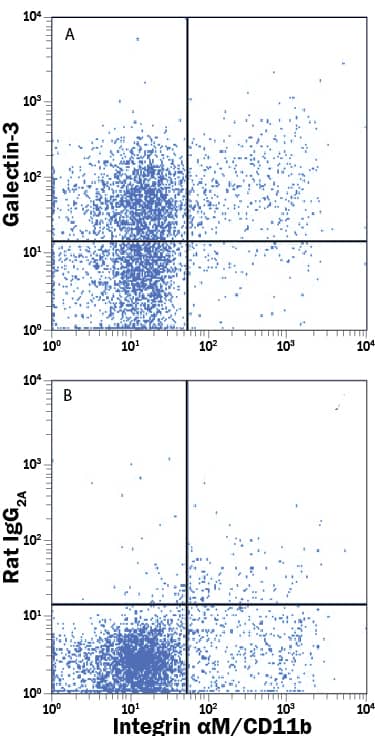Mouse Galectin-3 PE-conjugated Antibody
R&D Systems, part of Bio-Techne | Catalog # FAB1197P


Key Product Details
Species Reactivity
Validated:
Cited:
Applications
Validated:
Cited:
Label
Antibody Source
Product Specifications
Immunogen
Ala2-Ile264
Accession # P16110
Specificity
Clonality
Host
Isotype
Scientific Data Images for Mouse Galectin-3 PE-conjugated Antibody
Detection of Galectin‑3 in Mouse Splenocytes by Flow Cytometry.
Mouse splenocytes were stained with Rat Anti-Mouse Integrin aM/CD11b APC-conjugated Monoclonal Antibody (Catalog # FAB1124A) and either (A) Rat Anti-Mouse Galectin-3 PE-conjugated Monoclonal Antibody (Catalog # FAB1197P) or (B) Rat IgG2APhycoerythrin Isotype Control (Catalog # IC006P). View our protocol for Staining Membrane-associated Proteins.Applications for Mouse Galectin-3 PE-conjugated Antibody
Flow Cytometry
Sample: Mouse splenocytes
Formulation, Preparation, and Storage
Purification
Formulation
Shipping
Stability & Storage
Background: Galectin-3
The galectins constitute a large family of carbohydrate-binding proteins with specificity for N-acetyl-lactosamine-containing glycoproteins. At least 14 mammalian galectins, which share structural similarities in their carbohydrate recognition domains (CRD), have been identified. The galectins have been classified as either prototype galectins (-1, -2, -5, -7, -10, -11, -13, -14), which contain one CRD and exist either as a monomer or a noncovalent homodimer; chimera galectins (Galectin-3) containing one CRD linked to a nonlectin domain; or tandem-repeat galectins (-4, -6, -8, -9, -12) that consist of two CRDs joined by a linker peptide. Galectins lack a classical signal peptide and can be localized to the cytosolic compartments where they have intracellular functions. However, via one or more as yet unidentified non-classical secretory pathways, galectins can also be secreted to act extracellularly. Individual members of the galectin family have different tissue distribution profiles and exhibit subtle differences in their carbohydrate-binding specificities. Each family member may preferentially bind to a unique subset of cell-surface glycoproteins. Galectin-3, also known as Mac-2, L29, CBP35, and epsilonBP, is a chimera galectin that has a tendency to dimerize. Galectin-3 is expressed in tumor cells, macrophages, activated T cells, osteoclasts, epithelial cells, and fibroblasts. It binds various matrix glycoproteins including laminin, fibronectin, LAMPS, 90K/Mac-2BP, MP20, and CEA. Galectin-3 promotes cell growth and proliferation for many cell types. Galectin-3 acts intracellularly to prevent apoptosis. Depending on the cell types, Galectin-3 exhibits pro- or anti-adhesive properties. In particular, it is reported to bind NG2 when complexed to Integrin alpha3 beta1 on endothelial cells, initiating cell motility and angiogenesis. Galectin-3 has proinflammatory activities in vitro and in vivo. It induces Th1 type and inhibits Th2 type cytokine production. Galectin-3 chemoattracts monocytes and macrophages. It activates and degranulates basophils and mast cells. Elevated circulating levels of Galectin-3 has been show to correlate with the malignant potential of several types of cancer, suggesting that Galectin-3 is also involved in tumor growth and metastasis. Human and mouse Galectin-3 shares approximately 80% amino acid sequence similarity.
Alternate Names
Gene Symbol
UniProt
Additional Galectin-3 Products
Product Documents for Mouse Galectin-3 PE-conjugated Antibody
Product Specific Notices for Mouse Galectin-3 PE-conjugated Antibody
For research use only